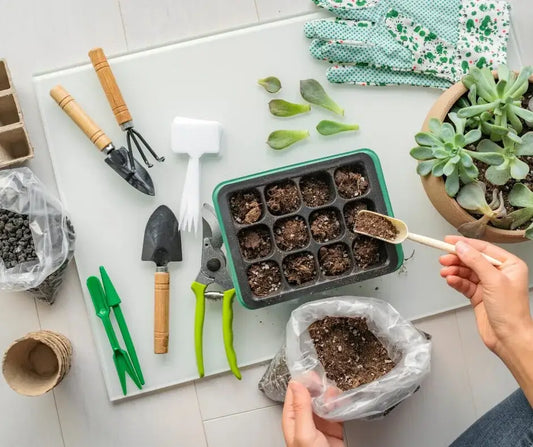Who doesn’t want more of a good thing? As your houseplants sink their roots happily into their Coast of Maine Bar Harbor Blend Potting Soil to grow lush and lovely—making more becomes a truly tempting option. And propagating houseplants is often incredibly easy!
The Why
Why make more? Well, when you increase to several containers of the same plant, you can stage a chorus line of similar plants to create a border on your windowsill—just like outdoors. Or, you can sprinkle the same plant in several windows of a room to create color echoes—again, like the repetition created in the garden outside. Plus, just think how popular you will become when you share your favorite houseplant with visiting friends and family. You’ll make houseplant converts and spread the craziness. You might even save someone’s sanity with an infusion of nature when they begin to feel housebound.
Spreading the cheer makes friends and influences people—but houseplants will also love you for working with them. They love being divided, pruned, and groomed. Pot bound houseplants will be eternally grateful when you divide them up and give them fresh soil. They delight in a haircut and thank you by branching out even more. Your houseplants are going to thank you for sending them to the beauty parlor. Here’s how it’s done:
The Cutting Edge
Absolutely, you can get snippy with your houseplants. First, check to make sure the plant is not patented or propagation prohibited. If all is free and clear, take cuttings. When a plant has roots coming from the stems (which is the case with an ivy, for example), the process has already started and you’re halfway to being a new plant parent.  You can just take a pair of pruning shears and remove a snippet with the roots. Tuck the cutting in a small pot filled with potting soil. Firm it in, give it a good drink, and place it in a location with indirect light, watering it regularly while the cutting becomes established.
You can just take a pair of pruning shears and remove a snippet with the roots. Tuck the cutting in a small pot filled with potting soil. Firm it in, give it a good drink, and place it in a location with indirect light, watering it regularly while the cutting becomes established.
If your houseplant has some extra growth, take cuttings and root your sprigs in soil. Rather than fresh, wispy tender growth, wait for stems to become turgid and then make a 3-inch cutting.  Remove the lower leaves, apply rooting hormone to the newly cut stem, and bury it an inch or so in a small pot filled with potting soil. Firm it in, water it generously, place it in a shady location, remember to continue watering to keep the soil damp, and wait. After a few weeks, roots should begin to form.
Remove the lower leaves, apply rooting hormone to the newly cut stem, and bury it an inch or so in a small pot filled with potting soil. Firm it in, water it generously, place it in a shady location, remember to continue watering to keep the soil damp, and wait. After a few weeks, roots should begin to form.
The bonus? Your plant will love getting in shape for new spring and summer growth. Most houseplants love a haircut. In fact, they will be prompted to branch out and sprout new growth for a fuller, handsomer, more robust specimen.
Plant Parenthood
Some plants make babies all by themselves. For example, Euphorbia daigremontiana (mother of millions),  piggyback plants (Tolmeia menziesii), and mother ferns (Asplenium viviparum and Asplenium daucifolium) carry their babies right on their leaves. Basically, your work has been done by the parental plant. All you need to do is plant the progeny into their own containers with nutritious potting soil, making sure that newly formed roots are buried, and firm them in. Give the babies some water and they are good to go.
piggyback plants (Tolmeia menziesii), and mother ferns (Asplenium viviparum and Asplenium daucifolium) carry their babies right on their leaves. Basically, your work has been done by the parental plant. All you need to do is plant the progeny into their own containers with nutritious potting soil, making sure that newly formed roots are buried, and firm them in. Give the babies some water and they are good to go.
Dividing your Assets
Some plants such as members of the ginger family, members of the prayer plant family, some begonias, and succulents form colonies of plants with their own roots. With time, they become wider and wider—filling their container. Again, check to make sure the plant is not patented or propagation prohibited. If all is clear, simply pull the plant out of its container, grab one or more of the divisions (making sure that it has formed roots), pull it apart, and pot it separately in rich potting soil – firming the soil around the new roots. Shelter the new division from bright light for a couple of weeks while it acclimates to independent life. Meanwhile, repot its parent. Feel free to promote the parent to a larger container if the roots warrant a larger pot. Or you can keep it in the original container if you’ve taken off a generous chunk. Congratulations! Now you have riches to share!
 Written by award winning author, Tovah Martin. Photos also taken by Tovah Martin. Find her books and more information on her website: tovahmartin.com
Written by award winning author, Tovah Martin. Photos also taken by Tovah Martin. Find her books and more information on her website: tovahmartin.com













